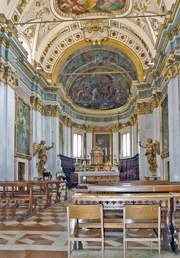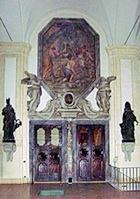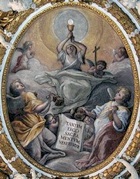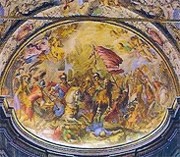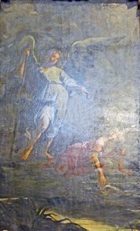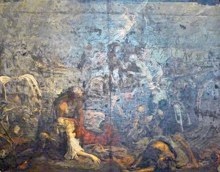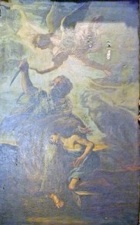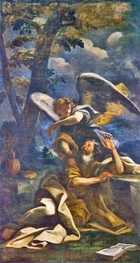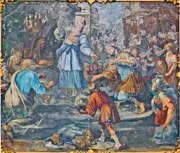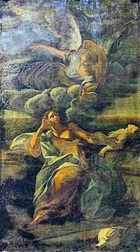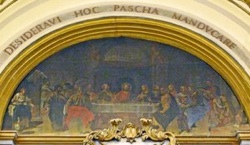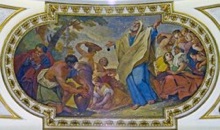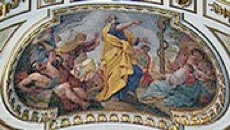The Compagnia del Sacramento, which was formed in 1511, originally had an altar in the Duomo. They built a chapel off the right aisle in 1541.
The inscription above the entrance records that it was rebuilt using a bequest from Girolamo Ortorio Paci. Construction took place in 1663-6, to a design by Giacomo Giorgetti. He also provided a design (1668) for the stucco decoration of the vaults.
Allegory of the Eucharist (1668)
Later Decoration of the Chapel (1670-77)
In December 1670, the Compagnia del Sacramento and Bishop Ludovico Giustiniani commissioned Giovanni Andrea Carlone, il Genovese to execute:
-
✴the fresco above the apse of the chapel;
-
✴three panels for the apse; and
-
✴six panels of miracles associated with the Sacrament for the walls.
His involvement on site seems to have ended with the execution of the fresco (1673) of the sacrifice of Elijah above the entrance to the chapel, which is signed and dated by inscription. However, representatives of the Compagnia del Sacramento continued to write to the artist in Rome thereafter, and the frames of four of the panels on the walls bear his signature and the date 1677.
Gideon and the Midianites
This fresco by Giovanni Andrea Carlone is in the lunette above the apse. When the Midianites threatened the Israelites in the wilderness, an angel commanded the judge Gideon to lead them into battle. The fresco depicts Gideon leading a force of only 300 men in a surprise attack in which the superior forces of the Midianites were defeated. Gideon then declined to become the king of the Israelites, saying that God would be their leader.
Panels in the Apse
These panels by Giovanni Andrea Carlone
depict:
-
✴the Nativity;
-
✴the supper at Emmaus (illustrated here); and
-
✴the Resurrection.
Panels on the Walls
These panels by Giovanni Andrea Carlone depict (clockwise from panel on the left wall nearest the counter-facade):
Tobias and the angel
This is a scene from a rather involved saga in the apocryphal Book of Tobit. Tobit was a righteous Jewish exile after the fall of Jerusalem who was accidentally blinded. He sent his son Tobias on a journey during which an angel appeared as his companion. The angel directed Tobias to catch a fish and use its gall to cure his father's blindness. The fresco shows Tobias catching the fish under the angel's direction.
Prayer of David
David is shown praying for an end to the suffering of Israel. God answered this prayer by granting him victory over the Philistines, and by promising him that he would found a dynasty that would last forever. This was later seen as the promise of the coming of the Messiah, who would be from the House of David.
Sacrifice of Isaac
God tested Abraham by commanding him to sacrifice his son, Isaac. When Abraham was about to comply, God sent an angel to stay his hand and promised him that he would become the father of a great nation.
Elijah and the angel
The fresco shows an angel bringing bread to Elijah in the desert after he had been forced to flee from Jezebel.
David receives the bread from the priest Ahimelech
When David was forced to flee after having offended King Saul, he begged for bread from the priest Ahimelech. The priest gave him consecrated loaves because he had nothing else. The representation here shows this event as prefiguring the celebration of Mass.
Hagar in the dessert
Hagar was the mother of Abrahams illegitimate son, Ishmael. When his aged wife Sarah conceived, Abraham reluctantly sent Hagar and Ishmael into the dessert, giving them bread and water for their journey. The fresco shows them near to death, when an angel appeared with water and promised Hagar that Ishmael would give rise to a great nation. (He founded the Ishmaelite tribe, the forerunners of the Arab nation.)
Sacrifice of Elijah (1673)
This fresco above the entrance, which is signed by Giovanni Andrea Carlone
and dated by inscription, depicts the contest between Elijah and the prophets of Baal. Each prepared to sacrifice a bullock, and called on God to light the fire. While Elijah’s prayer was answered, that of the prophets of Baal was not. Thus the people returned to God and killed the prophets who had tried to lead them astray.
Final Phase of Decoration
Last Supper (1696)
This panel in the lunette on the counter-facade is signed by Brother Emanuele da Como and dated by inscription.
Panels in the Vaults (early 18th century)
These two undocumented panels are attributed to Giovanni Antonio Grecolini on stylistic grounds. They depict scenes from the biblical account of Moses and the Israelites in the wilderness:
-
✴the descent of manna to feed the people; and
-
✴the bronze serpent on a cross, which God ordered Moses to make, promising that those bitten by it would be saved.
Read more:
F. Santucci (Ed.), "La Cattedrale di San Rufino in Assisi", Assisi (1999)
Return to San Rufino.
Return to the home page on Assisi.


